What. Animal Lays Eggs Smaller Than A Dime


Diagram of a chicken egg in its ninth day. Membranes: allantois, chorion, amnion, and vitellus/ yolk.

Six commercial eggs — view from the top against a white groundwork
An egg is the organic vessel containing the zygote in which an embryo develops until it can survive on its ain, at which point the animate being hatches. An egg results from fertilization of an egg cell. Most arthropods, vertebrates (excluding live-bearing mammals), and mollusks lay eggs, although some, such every bit scorpions, do not.
Reptile eggs, bird eggs, and monotreme eggs are laid out of h2o and are surrounded by a protective shell, either flexible or inflexible. Eggs laid on land or in nests are usually kept within a warm and favorable temperature range while the embryo grows. When the embryo is fairly developed it hatches, i.e., breaks out of the egg's shell. Some embryos have a temporary egg molar they use to crack, pip, or break the eggshell or covering.
The largest recorded egg is from a whale shark and was 30 cm × 14 cm × nine cm (11.8 in × v.five in × 3.5 in) in size.[1] Whale shark eggs typically hatch within the female parent. At 1.5 kg (iii.three lb) and upwardly to 17.8 cm × 14 cm (7.0 in × five.5 in), the ostrich egg is the largest egg of whatever living bird,[2] though the extinct elephant bird and some non-avian dinosaurs laid larger eggs. The bee hummingbird produces the smallest known bird egg, which weighs half of a gram (effectually 0.02 oz). Some eggs laid by reptiles and most fish, amphibians, insects, and other invertebrates tin can be even smaller.
Reproductive structures similar to the egg in other kingdoms are termed "spores," or in spermatophytes "seeds," or in gametophytes "egg cells".
Eggs of different animal groups
Several major groups of animals typically have readily distinguishable eggs.
| Class | Types of eggs | Development |
|---|---|---|
| Jawless fish | Mesolecithal eggs, particularly large in hagfish[three] | Larval stage in lampreys, direct development in hagfish.[iv] [5] |
| Cartilaginous fish | Macrolecithal eggs with egg capsule[three] | Direct evolution, viviparity in some species[6] |
| Bony fish | Macrolecithal eggs, small to medium size, large eggs in the coelacanth[7] | Larval phase, ovovivipary in some species.[8] |
| Amphibians | Medium-sized mesolecithal eggs in all species.[7] | Tadpole stage, direct evolution in some species.[7] |
| Reptiles | Large macrolecithal eggs, develop independent of water.[nine] | Direct development, some ovoviviparious |
| Birds | Big to very large macrolecithal eggs in all species, develop independent of water.[iii] | The young more or less fully developed, no distinct larval stage. |
| Mammals | Macrolecithal eggs in monotremes and marsupials, farthermost microlecithal eggs in placental mammals.[iii] | Young trivial developed with indistinct larval stage in monotremes and marsupials, direct development in placentals. |
Fish and amphibian eggs
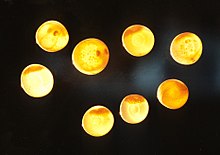
Salmon eggs in different stages of development. In some only a few cells grow on top of the yolk, in the lower right the blood vessels surroundings the yolk and in the upper left the black eyes are visible.

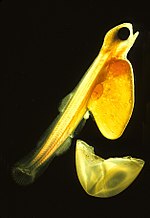
Salmon fry hatching. The larva has grown effectually the remains of the yolk and the remains of the soft, transparent egg are discarded.
The most common reproductive strategy for fish is known as oviparity, in which the female lays undeveloped eggs that are externally fertilized past a male person. Typically large numbers of eggs are laid at in one case (an adult female cod can produce 4–6 million eggs in one spawning) and the eggs are and then left to develop without parental care. When the larvae hatch from the egg, they often carry the remains of the yolk in a yolk sac which continues to nourish the larvae for a few days as they larn how to swim. One time the yolk is consumed, there is a critical point after which they must learn how to hunt and feed or they volition die.
A few fish, notably the rays and most sharks utilise ovoviviparity in which the eggs are fertilized and develop internally. However, the larvae withal grow within the egg consuming the egg's yolk and without any straight nourishment from the mother. The female parent then gives birth to relatively mature young. In certain instances, the physically most developed offspring will devour its smaller siblings for further nutrition while still within the female parent'southward body. This is known as intrauterine cannibalism.
In sure scenarios, some fish such as the hammerhead shark and reef shark are viviparous, with the egg existence fertilized and developed internally, but with the mother too providing straight nourishment.
The eggs of fish and amphibians are jellylike. Cartilaginous fish (sharks, skates, rays, chimaeras) eggs are fertilized internally and exhibit a wide variety of both internal and external embryonic development. Most fish species spawn eggs that are fertilized externally, typically with the male inseminating the eggs later the female lays them. These eggs exercise not have a shell and would dry out in the air. Even air-breathing amphibians lay their eggs in water, or in protective foam every bit with the Coast foam-nest treefrog, Chiromantis xerampelina.
Bird eggs
Bird eggs are laid by females and incubated for a time that varies co-ordinate to the species; a single young hatches from each egg. Boilerplate clutch sizes range from i (as in condors) to near 17 (the grey partridge). Some birds lay eggs even when non fertilized (e.k. hens); it is not uncommon for pet owners to notice their lone bird nesting on a clutch of unfertilized eggs, which are sometimes called wind-eggs.
Colours
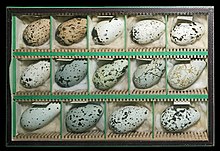
The default color of vertebrate eggs is the white of the calcium carbonate from which the shells are made, but some birds, mainly passerines, produce colored eggs. The paint biliverdin and its zinc chelate give a dark-green or blue ground color, and protoporphyrin produces reds and browns every bit a footing color or as spotting.
Not-passerines typically have white eggs, except in some ground-nesting groups such as the Charadriiformes, sandgrouse and nightjars, where camouflage is necessary, and some parasitic cuckoos which have to match the passerine host's egg. Most passerines, in contrast, lay colored eggs, even if there is no need of cryptic colors.
Nonetheless some have suggested that the protoporphyrin markings on passerine eggs actually human activity to reduce brittleness past interim as a solid-country lubricant.[10] If at that place is insufficient calcium bachelor in the local soil, the egg shell may be thin, especially in a circle around the broad end. Protoporphyrin speckling compensates for this, and increases inversely to the amount of calcium in the soil.[11]
For the same reason, later eggs in a clutch are more than spotted than early ones as the female person's store of calcium is depleted.
The color of individual eggs is also genetically influenced, and appears to be inherited through the mother simply, suggesting that the cistron responsible for pigmentation is on the sex-determining W chromosome (female birds are WZ, males ZZ).
It used to be idea that color was practical to the shell immediately before laying, but subsequent research shows that coloration is an integral office of the evolution of the vanquish, with the same poly peptide responsible for depositing calcium carbonate, or protoporphyrins when in that location is a lack of that mineral.
In species such as the common guillemot, which nest in large groups, each female person'south eggs have very different markings, making it easier for females to identify their own eggs on the crowded cliff ledges on which they breed.
Shell
Bird eggshells are diverse. For example:
- cormorant eggs are rough and chalky
- tinamou eggs are shiny
- duck eggs are oily and waterproof
- cassowary eggs are heavily pitted
Tiny pores in bird eggshells allow the embryo to breathe. The domestic hen's egg has around 7000 pores.[12]
Some bird eggshells have a blanket of vaterite spherules, which is a rare polymorph of calcium carbonate. In Greater Ani Crotophaga major this vaterite coating is thought to act as a shock absorber, protecting the calcite beat out from fracture during incubation, such as colliding with other eggs in the nest.[13]
Shape

Well-nigh bird eggs take an oval shape, with one end rounded and the other more pointed. This shape results from the egg beingness forced through the oviduct. Muscles contract the oviduct behind the egg, pushing it frontwards. The egg'southward wall is nonetheless shapeable, and the pointed end develops at the dorsum. Long, pointy eggs are an incidental outcome of having a streamlined body typical of birds with strong flying abilities; flight narrows the oviduct, which changes the blazon of egg a bird can lay.[14] Cliff-nesting birds frequently accept highly conical eggs. They are less likely to curlicue off, disposed instead to roll around in a tight circle; this trait is likely to have arisen due to evolution via natural selection. In dissimilarity, many pigsty-nesting birds have about spherical eggs.[15]
Predation
Many animals feed on eggs. For example, primary predators of the blackness oystercatcher's eggs include raccoons, skunks, mink, river and sea otters, gulls, crows and foxes. The stoat (Mustela erminea) and long-tailed weasel (1000. frenata) steal ducks' eggs. Snakes of the genera Dasypeltis and Elachistodon specialize in eating eggs.
Brood parasitism occurs in birds when i species lays its eggs in the nest of another. In some cases, the host'southward eggs are removed or eaten by the female, or expelled past her chick. Brood parasites include the cowbirds and many Old World cuckoos.
Diverse examples
-

An average whooping crane egg is 102 mm (four.0 in) long and weighs 208 thousand (seven.3 oz)
-
Egg of a senegal parrot, a bird that nests in tree holes, on a ane cm (0.39 in) grid
-
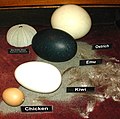
-

-

-
-

Egg from a chicken compared to a 1 euro money, great tit egg and a corn grain
-

A spherical chicken egg
Amniote eggs and embryos

Similar amphibians, amniotes are air-breathing vertebrates, but they accept complex eggs or embryos, including an amniotic membrane. Amniotes include reptiles (including dinosaurs and their descendants, birds) and mammals.
Reptile eggs are often rubbery and are always initially white. They are able to survive in the air. Oftentimes the sex activity of the developing embryo is determined by the temperature of the environment, with cooler temperatures favouring males. Non all reptiles lay eggs; some are viviparous ("live birth").
Dinosaurs laid eggs, some of which have been preserved as petrified fossils.
Among mammals, early on extinct species laid eggs, as do platypuses and echidnas (spiny anteaters). Platypuses and two genera of echidna are Australian monotremes. Marsupial and placental mammals practice not lay eggs, but their unborn immature do have the complex tissues that identify amniotes.
Mammalian eggs
The eggs of the egg-laying mammals (the platypus and the echidnas) are macrolecithal eggs very much like those of reptiles. The eggs of marsupials are too macrolecithal, just rather small-scale, and develop inside the torso of the female person, just practise not form a placenta. The young are built-in at a very early phase, and tin exist classified every bit a "larva" in the biological sense.[16]
In placental mammals, the egg itself is void of yolk, only develops an umbilical cord from structures that in reptiles would form the yolk sac. Receiving nutrients from the female parent, the fetus completes the development while within the uterus.
Invertebrate eggs

Eggs are common among invertebrates, including insects, spiders, mollusks, and crustaceans.
Evolution and structure
All sexually reproducing life, including both plants and animals, produces gametes. The male gamete cell, sperm, is usually motile whereas the female gamete cell, the ovum, is generally larger and sessile. The male and female gametes combine to produce the zygote cell. In multicellular organisms the zygote afterwards divides in an organised manner into smaller more than specialised cells, so that this new individual develops into an embryo. In most animals the embryo is the sessile initial stage of the individual life cycle, and is followed past the emergence (that is, the hatching) of a motile stage. The zygote or the ovum itself or the sessile organic vessel containing the developing embryo may exist chosen the egg.
A contempo proposal suggests that the phylotypic animal body plans originated in cell aggregates before the existence of an egg stage of development. Eggs, in this view, were later evolutionary innovations, selected for their function in ensuring genetic uniformity among the cells of incipient multicellular organisms.[17]
Scientific classifications
Scientists oft classify animal reproduction according to the caste of development that occurs earlier the new individuals are expelled from the adult body, and by the yolk which the egg provides to attend the embryo.
Egg size and yolk
Vertebrate eggs tin can be classified past the relative corporeality of yolk. Simple eggs with footling yolk are called microlecithal, medium-sized eggs with some yolk are chosen mesolecithal, and large eggs with a large full-bodied yolk are chosen macrolecithal.[7] This nomenclature of eggs is based on the eggs of chordates, though the basic principle extends to the whole animal kingdom.
Microlecithal


Small eggs with little yolk are chosen microlecithal. The yolk is evenly distributed, and then the cleavage of the egg prison cell cuts through and divides the egg into cells of fairly like sizes. In sponges and cnidarians the dividing eggs develop directly into a simple larva, rather like a morula with cilia. In cnidarians, this phase is called the planula, and either develops directly into the developed animals or forms new adult individuals through a process of budding.[eighteen]
Microlecithal eggs require minimal yolk mass. Such eggs are found in flatworms, roundworms, annelids, bivalves, echinoderms, the lancelet and in most marine arthropods.[19] In anatomically simple animals, such equally cnidarians and flatworms, the fetal development tin exist quite short, and even microlecithal eggs tin undergo direct development. These pocket-sized eggs can be produced in large numbers. In animals with high egg mortality, microlecithal eggs are the norm, equally in bivalves and marine arthropods. However, the latter are more circuitous anatomically than e.chiliad. flatworms, and the small microlecithal eggs do non let full development. Instead, the eggs hatch into larvae, which may be markedly dissimilar from the developed animal.
In placental mammals, where the embryo is nourished by the female parent throughout the whole fetal period, the egg is reduced in size to essentially a naked egg cell.
Mesolecithal

Mesolecithal eggs have comparatively more than yolk than the microlecithal eggs. The yolk is full-bodied in one role of the egg (the vegetal pole), with the jail cell nucleus and virtually of the cytoplasm in the other (the animal pole). The cell cleavage is uneven, and mainly full-bodied in the cytoplasma-rich animal pole.[3]
The larger yolk content of the mesolecithal eggs allows for a longer fetal development. Comparatively anatomically unproblematic animals will be able to go through the full development and leave the egg in a form reminiscent of the adult animal. This is the situation constitute in hagfish and some snails.[4] [19] Animals with smaller size eggs or more advanced beefcake will however have a singled-out larval stage, though the larva will be basically similar to the adult animal, as in lampreys, coelacanth and the salamanders.[3]
Macrolecithal
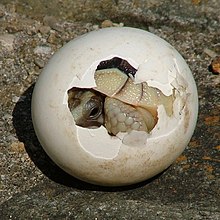
A baby tortoise begins to emerge "fully developed" from its macrolecithal egg.
Eggs with a large yolk are chosen macrolecithal. The eggs are usually few in number, and the embryos have enough food to go through full fetal evolution in nigh groups.[7] Macrolecithal eggs are only plant in selected representatives of two groups: Cephalopods and vertebrates.[vii] [twenty]
Macrolecithal eggs go through a unlike type of development than other eggs. Due to the large size of the yolk, the cell division can not carve up up the yolk mass. The fetus instead develops as a plate-similar structure on top of the yolk mass, and only envelopes it at a after stage.[vii] A portion of the yolk mass is still present equally an external or semi-external yolk sac at hatching in many groups. This form of fetal development is common in bony fish, even though their eggs can be quite small-scale. Despite their macrolecithal structure, the small size of the eggs does non allow for directly development, and the eggs hatch to a larval stage ("fry"). In terrestrial animals with macrolecithal eggs, the large volume to surface ratio necessitates structures to assistance in transport of oxygen and carbon dioxide, and for storage of waste products so that the embryo does not suffocate or become poisoned from its own waste material while inside the egg, see amniote.[ix]
In addition to bony fish and cephalopods, macrolecithal eggs are constitute in cartilaginous fish, reptiles, birds and monotreme mammals.[three] The eggs of the coelacanths tin can reach a size of 9 cm (3.5 in) in diameter, and the young go through full development while in the uterus, living on the copious yolk.[21]
Egg-laying reproduction
Animals are commonly classified by their style of reproduction, at the well-nigh full general level distinguishing egg-laying (Latin. oviparous) from live-begetting (Latin. viviparous).
These classifications are divided into more detail according to the development that occurs before the offspring are expelled from the adult'south body. Traditionally:[22]
- Ovuliparity means the female spawns unfertilized eggs (ova), which must and then exist externally fertilised. Ovuliparity is typical of bony fish, anurans, echinoderms, bivalves and cnidarians. Well-nigh aquatic organisms are ovuliparous. The term is derived from the diminutive pregnant "fiddling egg".
- Oviparity is where fertilisation occurs internally and and so the eggs laid by the female are zygotes (or newly developing embryos), often with of import outer tissues added (for example, in a craven egg, no part exterior of the yolk originates with the zygote). Oviparity is typical of birds, reptiles, some cartilaginous fish and nearly arthropods. Terrestrial organisms are typically oviparous, with egg-casings that resist evaporation of moisture.
- Ovo-viviparity is where the zygote is retained in the adult'south body but there are no trophic (feeding) interactions. That is, the embryo still obtains all of its nutrients from inside the egg. Most live-bearing fish, amphibians or reptiles are actually ovoviviparous. Examples include the reptile Anguis fragilis, the body of water horse (where zygotes are retained in the male's ventral "marsupium"), and the frogs Rhinoderma darwinii (where the eggs develop in the song sac) and Rheobatrachus (where the eggs develop in the breadbasket).
- Histotrophic viviparity ways embryos develop in the female's oviducts but obtain nutrients by consuming other ova, zygotes or sibling embryos (oophagy or adelphophagy). This intra-uterine cannibalism occurs in some sharks and in the black salamander Salamandra atra. Marsupials excrete a "uterine milk" supplementing the nourishment from the yolk sac.[23]
- Hemotrophic viviparity is where nutrients are provided from the female person's blood through a designated organ. This most ordinarily occurs through a placenta, constitute in most mammals. Similar structures are plant in some sharks and in the lizard Pseudomoia pagenstecheri.[24] [25] In some hylid frogs, the embryo is fed by the mother through specialized gills.[26]
The term hemotropic derives from the Latin for blood-feeding, contrasted with histotrophic for tissue-feeding.[27]
Human use
Food
Eggs laid by many unlike species, including birds, reptiles, amphibians, and fish, have probably been eaten past people for millennia. Popular choices for egg consumption are chicken, duck, roe, and caviar, just by a broad margin the egg most often humanly consumed is the chicken egg, typically unfertilized.
Eggs and Kashrut
According to the Kashrut, that is the set of Jewish dietary laws, kosher food may be consumed according to halakha (Jewish law). Kosher meat and milk (or derivatives) cannot exist mixed (Deuteronomy 14:21) or stored together. Eggs are considered pareve (neither meat nor dairy) despite existence an animal production and can be mixed with either milk or kosher meat. Mayonnaise, for case, is unremarkably marked "pareve" despite past definition containing egg.[28]
Vaccine manufacture
Many vaccines for infectious diseases are produced in fertile craven eggs. The basis of this technology was the discovery in 1931 by Alice Miles Woodruff and Ernest William Goodpasture at Vanderbilt University that the rickettsia and viruses that cause a multifariousness of diseases will grow in chicken embryos. This enabled the development of vaccines against influenza, chicken pox, smallpox, xanthous fever, typhus, Rocky mountain spotted fever and other diseases.
Culture
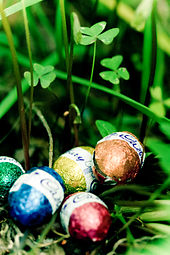
Eggs are an important symbol in folklore and mythology, ofttimes representing life and rebirth, healing and protection, and sometimes featuring in creation myths.[29] Egg ornament is a mutual practice in many cultures worldwide. Christians view Easter eggs as symbolic of the resurrection of Jesus Christ.[30] A pop Easter tradition in some parts of the world is the ornamentation of hard-boiled eggs (usually past dyeing, just ofttimes by hand-painting or spray-painting). Adults often hide the eggs for children to find, an activity known as an Easter egg hunt. A similar tradition of egg painting exists in areas of the globe influenced past the culture of Persia. Before the spring equinox in the Persian New year tradition (chosen Norouz), each family unit member decorates a hard-boiled egg and sets them together in a basin. The tradition of a dancing egg is held during the feast of Corpus Christi in Barcelona and other Catalan cities since the 16th century. It consists of an emptied egg, positioned over the water jet from a fountain, which starts turning without falling.[31]
Although a nutrient item, raw eggs are sometimes thrown at houses, cars, or people. This act, known commonly every bit "egging" in the various English-speaking countries, is a pocket-size form of vandalism and, therefore, commonly a law-breaking and is capable of damaging property (egg whites tin degrade certain types of vehicle paint) as well as potentially causing serious center injury. On Halloween, for case, flim-flam or treaters have been known to throw eggs (and sometimes flour) at holding or people from whom they received nothing.[ citation needed ] Eggs are as well often thrown in protests, as they are cheap and nonlethal, yet very messy when broken.[32]
Collecting
Egg collecting was a popular hobby in some cultures, including European Australians. Traditionally, the embryo would exist removed earlier a collector stored the egg shell.[33]
Collecting eggs of wild birds is now banned by many jurisdictions, as the practice can threaten rare species. In the United Kingdom, the practice is prohibited by the Protection of Birds Act 1954 and Wild animals and Countryside Deed 1981.[34] On the other hand, ongoing underground trading is becoming a serious result.[35]
Since the protection of wild bird eggs was regulated, early collections accept come to the museums as curiosities. For example, the Australian Museum hosts a collection of near xx,000 registered clutches of eggs,[36] and the collection in Western Australia Museum has been archived in a gallery.[37] Scientists regard egg collections as a good natural-history data, as the details recorded in the collectors' notes take helped them to understand birds' nesting behaviors.[38]
Gallery
-

Insect eggs, in this case those of the Emperor gum moth, are oftentimes laid on the underside of leaves.
-

Fish eggs, such as these herring eggs are oftentimes transparent and fertilized after laying.
-

See too
- List of egg topics
- Animal shell
- Butterfly eggs
- Egg white
- Fossil egg
- Haugh unit
- Oology
- Oval
- Ovary
- Ovulation
- Oviparous
- Trophic egg
References
- ^ "Whale Shark – Cartilaginous Fish". SeaWorld Parks & Amusement. Archived from the original on 2014-06-09. Retrieved 2014-06-26 .
- ^ D.R. Khanna (one Jan 2005). Biology of Birds. Discovery Publishing House. p. 130. ISBN978-81-7141-933-3. Archived from the original on 10 May 2016.
- ^ a b c d e f g Hildebrand, M. & Gonslow, Thousand. (2001): Analysis of Vertebrate Structure. 5th edition. John Wiley & Sons, Inc. New York Metropolis
- ^ a b Gorbman, A. (June 1997). "Hagfish development". Zoological Science. fourteen (3): 375–390. doi:ten.2108/zsj.14.375. S2CID 198158310.
- ^ Hardisty, M. Due west., and Potter, I. C. (1971). The Biological science of Lampreys 1st ed. (Academic Press Inc.).
- ^ Leonard J. V. Compagno (1984). Sharks of the World: An annotated and illustrated catalogue of shark species known to date. Food and Agriculture Organization of the United nations. ISBN 92-5-104543-7. OCLC 156157504.
- ^ a b c d e f g Romer, A. S. & Parsons, T. S. (1985): The Vertebrate Torso. (6th ed.) Saunders, Philadelphia.
- ^ Peter Scott: Livebearing Fishes, p. xiii. Tetra Press 1997. ISBN 1-56465-193-two
- ^ a b Stewart J. R. (1997): Morphology and evolution of the egg of oviparous amniotes. In: S. Sumida and K. Martin (ed.) Amniote Origins-Completing the Transition to State (1): 291–326. London: Academic Printing.
- ^ Solomon, S.E. (1987). Egg crush pigmentation. In Egg Quality: Current Problems and Recent Advances (eds R.Chiliad. Wells & C.G. Belyarin). Butterworths, London, pp. 147–157.
- ^ Gosler, Andrew G.; James P. Higham; S. James Reynolds (2005). "Why are birds' eggs speckled?". Ecology Letters. viii (10): 1105–1113. doi:10.1111/j.1461-0248.2005.00816.10.
- ^ "The Parts of the Egg". www.sites.ext.vt.edu. Archived from the original on November 23, 2016.
- ^ Portugal, J. P.; Bowen, J.; Riehl, C. (2018). "A rare mineral, vaterite, acts as a shock absorber in the eggshell of a communally nesting bird" (PDF). Ibis. 160 (1): 173–178. doi:x.1111/ibi.12527.
- ^ Immature, Ed (22 June 2017). "Why Are Bird Eggs Egg-Shaped? An Eggsplainer". The Atlantic. Archived from the original on 24 June 2017. Retrieved 23 June 2017.
- ^ Yutaka Nishiyama (2012). "The Mathematics of Egg Shape" (PDF). International Journal of Pure and Applied Mathematics. 78 (5): 679–689.
- ^ Colbert, H.East & Morales, M. (1991): Development of the Vertebrates – A History of Backboned Animals Through Time. 4. utgave. John Wiley & Sons inc, New York Urban center. 470 pages ISBN 0-471-85074-8
- ^ Newman, S.A. (2011). "Animal egg as evolutionary innovation: a solution to the 'embryonic hourglass' puzzle". Journal of Experimental Zoology Part B: Molecular and Developmental Evolution. 316 (7): 467–483. doi:10.1002/jez.b.21417. PMID 21557469.
- ^ Reitzel, A.M.; Sullivan, J.C; Finnery, J.R (2006). "Qualitative shift to indirect development in the parasitic sea anemone Edwardsiella lineata". Integrative and Comparative Biology. 46 (half-dozen): 827–837. doi:ten.1093/icb/icl032. PMID 21672788.
- ^ a b Barns, R.D. (1968): Invertebrate Zoology. West. B. Saunders Company, Philadelphia. 743 pages
- ^ Nixon, M. & Messenger, J.B (eds) (1977): The Biology of Cephalopods. Symposium of the Zoological Club of London, pp 38–615
- ^ Fricke, H.Due west. & Frahm, J. (1992): Evidence for lecithotrophic viviparity in the living coelacanth. Naturwissenschaften no 79: pp. 476–479
- ^ Thierry Lodé 2001. Les stratégies de reproduction des animaux (reproduction strategies in fauna kingdom). Eds Dunod Sciences, Paris
- ^ USA, David O. Norris, Ph.D., Professor Emeritus, Department of Integrative Physiology, University of Colorado at Boulder, Colorado, USA, James A. Carr, Ph.D., faculty director, Joint Admission Medical Programme, Section of Biological Sciences, Texas Tech Academy, Lubbock, Texas (2013). Vertebrate endocrinology (5th ed.). p. 349. ISBN978-0123948151. Archived from the original on i November 2017. Retrieved 25 November 2014.
- ^ Hamlett, William C. (1989). "Development and morphogenesis of the placenta in sharks". Journal of Experimental Zoology. 252 (S2): 35–52. doi:10.1002/jez.1402520406.
- ^ Jerez, Adriana; Ramírez-Pinilla, Martha Patricia (November 2003). "Morphogenesis of extraembryonic membranes and placentation inMabuya mabouya (Squamata, Scincidae)". Journal of Morphology. 258 (2): 158–178. doi:x.1002/jmor.10138. PMID 14518010. S2CID 782433.
- ^ Gorbman, edited by Peter G.T. Pang, Martin P. Schreibman; consulting editor, Aubrey (1986). Vertebrate endocrinology : fundamentals and biomedical implications. Orlando: Academic Press. p. 237. ISBN978-0125449014. Archived from the original on 1 November 2017. Retrieved 25 Nov 2014.
- ^ "Online Etymology Dictionary". Etymonline.com. Archived from the original on 2014-05-14. Retrieved 2013-07-27 .
- ^ Jewish Virtual Library Archived 2013-01-17 at the Wayback Machine Kashrut: Jewish Dietary Laws
- ^ Hall, Stephanie (2017-04-06). "The Aboriginal Fine art of Decorating Eggs | Folklife Today". blogs.loc.gov . Retrieved 2021-02-16 .
- ^ Barooah, Jahnabi (2012-04-02). "Easter Eggs: History, Origin, Symbolism And Traditions (PHOTOS)". Huffington Mail . Retrieved 2018-03-31 .
- ^ L'ou com balla Archived 2016-04-09 at the Wayback Car, Barcelona Cathedral.
- ^ Ramaswamy, Chitra (2015-ten-05). "Beyond a yolk: a brief history of egging every bit a political protest". The Guardian . Retrieved 2018-03-31 .
- ^ "Collecting bird eggs". echonewspaper.com.au. 2017-03-09. Retrieved 2018-03-31 .
- ^ "Protection of Birds Act 1954". www.legislation.gov.britain . Retrieved 2018-03-31 .
- ^ Wheeler, Timothy (2015-03-16), Poached , retrieved 2018-03-31
- ^ "Egg specimens - Australian Museum". australianmuseum.cyberspace.au . Retrieved 2018-03-31 .
- ^ "Explore our Egg Drove | Western Australian Museum". Western Australian Museum . Retrieved 2018-03-31 .
- ^ Golembiewski, Kate. "The Lost Victorian Art of Egg Collecting". The Atlantic . Retrieved 2018-03-31 .
External links
Source: https://en.wikipedia.org/wiki/Egg
Posted by: collinscapon1936.blogspot.com



0 Response to "What. Animal Lays Eggs Smaller Than A Dime"
Post a Comment